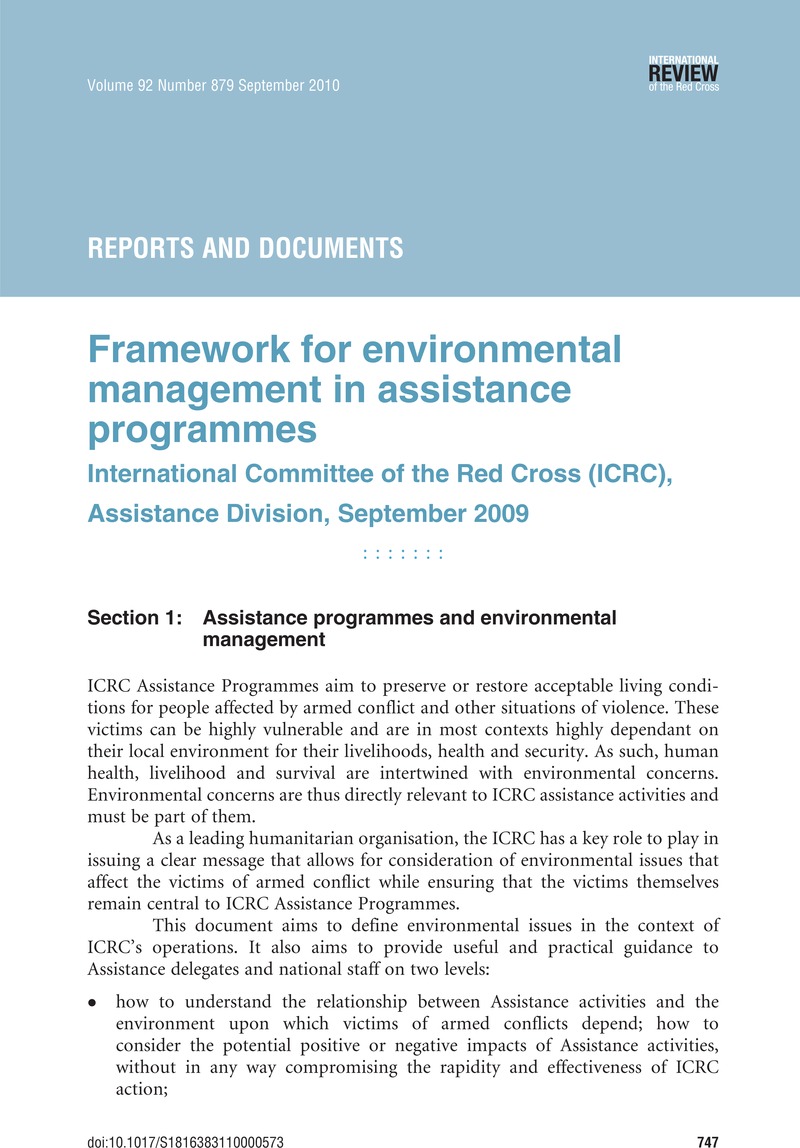No CrossRef data available.
International Committee of the Red Cross (ICRC), Assistance Division, September 2009
Published online by Cambridge University Press: 03 December 2010

1 Adapted from European Union, Council Directive of 27 June 1985 on the assessment of the effects of certain public and private projects on the environment (85/337/EEC), Article 3.
2 ICRC, ICRC Assistance Policy, adopted by the Assembly of the International Committee of the Red Cross on 29 April 2004, Public Version, in International Review of the Red Cross, Vol. 86, No. 855, September 2004, pp. 677–693.
3 Ibid., General Principle 3.1., p. 680.
4 Ibid., General Principle 3.2., p. 680.
5 Ibid., General Principle 3.3., p. 681.
6 Code of Conduct for the International Red Cross and Red Crescent Movement and NGOs in Disaster Relief, Principle 8, available at: http://www.ifrc.org/publicat/conduct/index.asp?navid=09_08 (last visited 30 September 2010).
7 ICRC Assistance Policy, above note 2, General Principle 3.4., p. 681.
8 Ibid., General Principle 3.5., p. 681.
9 Ibid., Strategy 4.1., p. 681.
10 For key references from other agencies for environmental considerations in Water and Habitat activities see, T.H. Thomas and D.B. Martinson, Roofwater Harvesting: A Handbook for Practitioners, IRC International Water and Sanitation Centre, Technical Paper Series, No. 49, Delft, The Netherlands, 2007; Norwegian Refugee Council (NRC)/The Camp Management Project (CMP), The Camp Management Toolkit, 2008, Chapter 6: Environment; Office for the Coordination of Humanitarian Affairs (OCHA) / United Nations Environment Programme (UNEP), Humanitarian Action and the Environment, Leaflet; UNEP / Swiss Resource Centre and Consultancies for Development (SKAT), After the Tsunami: Sustainable building guidelines for South-East Asia, 2007; United Nations High Commissioner for Refugees (UNHCR), Environmental Guidelines, Geneva, 2005; UNHCR, Refugee Operations and Environmental Management: Selected Lessons Learnt, Geneva, 2001; UNHCR, Refugee Operations and Environmental Management: Key Principles for Decision Making, Geneva, 1998; UNHCR, Cooking Options in Refugee Situations: A Handbook of Experiences in Energy Conservation and Alternative Fuels, Geneva, 2002; U.S. Agency for International Development (USAID), Environmental Guidelines for Small Scale Activities in Africa, March 2009, Part II, Chapter 3: Construction; Chapter 5: Energy Sources for Development, Chapter 15: Solid Waste and Chapter 16: Water Supply and Sanitation, all chapters available at: http://www.encapafrica.org/egssaa.htm (last visited 20 July 2010).
11 USAID, above note 10, Chapter 16, Table 3: Impacts and mitigation measures for specific water and sanitation activities and technologies, pp. 15–19.
12 Adapted from USAID, above note 10, Chapter 1, Table 4: Mitigation and Monitoring Table for Irrigation Impacts, pp. 33–35.
13 Adapted from USAID, above note 10, Chapter 3, Table 1: Environmental Mitigation and Monitoring Issues for Construction-Related Aspects of Development Projects, pp. 8–17.
14 Adapted from USAID, above note 10, Chapter 9, pp. 12–14.
15 For key references see ICRC, Regional Livestock Study in the Greater Horn of Africa, ICRC, 2005; Norwegian Refugee Council, above note 10; UNHCR, Environmental Guidelines, above note 10; UNHCR Refugee Operations …, above note 10; UNHCR, Forest Management in Refugee Situations – A Handbook of Sound Practices, UNHCR/The World Conservation Union (IUCN), Geneva, 2005; USAID, above note 10, Chapter 1: Agriculture and Irrigation; Chapter 7: Forestry: Reforestation, Natural Forest Management, and Agroforestry; and Chapter 11: Livestock.
16 See ICRC, The Environment & Agro Programmes: Analysis and Recommendations, Agro Workshop, Nairobi, 29 September to 3 October 2008.
17 See ICRC, above note 16, pp. 12–21. The examples in the table below were compiled at the Nairobi Agro Workshop by Economic Security Coordinators and complemented by USAID, above note 10.
18 Health Care Without Harm (HCWH), Environmentally Responsible Management of Health Care Waste with a Focus on Immunisation Waste, Washington, 2002; A. Prüss, E. Giroult and P. Rushbrook (eds), Safe management of wastes from health-care activities, World Health Organization (WHO), Geneva, 1999; WHO, Suggested Guiding Principles and Practices for the Sound Management of Hazardous Hospital Waste, New Delhi: Regional Office for South-East Asia, WHO, 2000; WHO, Guidelines for Safe Disposal of Unwanted Pharmaceuticals in and after Emergencies – Interagency Guidelines, 1999; USAID, above note 10, Chapter 8 Healthcare Waste: Generation, Handling, Treatment and Disposal; Oliver Morgan, Morris Tidball-Binz and Dana von Alphen (eds), Management of Dead Bodies after Disasters: A Field Manual for First Responders, Pan American Health Organization/WHO/ICRC/International Federation of Red Cross and Red Crescent Societies, Washington D.C., 2009.
19 Adapted from USAID, above note 10, Chapter 8: Healthcare Waste: Generation, Handling, Treatment and Disposal.